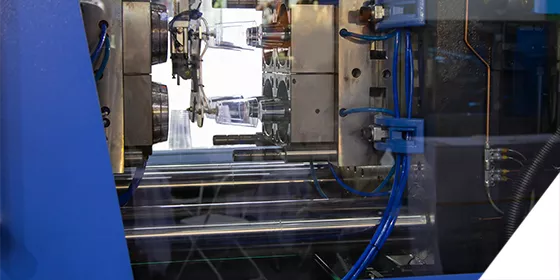Plastic Flow Analysis
Plastic flow analysis is a technique that uses mathematical models or computer simulation to predict the flow of molten plastic during the injection molding process. This information can be used to identify and predict potential problems with the part design, such as areas where the plastic may not flow properly, and other problems such as air traps, sink marks, Shrinkage, warpage, weld lines, etc. This technique can also be used to optimize the injection molding process, by identifying the optimal injection pressure and temperature settings to optimize the cycle time.
It is a valuable technique for improving the quality of injection molded parts. By identifying potential problems before the mold is built, engineers can avoid costly rework and downtime.

What are the benefits of using Plastic Flow Analysis
- Improved part quality: Plastic flow analysis can help to identify potential problems with the flow of the plastic, such as air traps, sink marks, and weld lines. This can help to improve the quality of the finished parts.
- Reduced cycle times: Plastic flow analysis can help to reduce cycle times by identifying the optimal injection pressure and temperature settings.
- Reduced costs: By identifying potential problems early on, plastic flow analysis can help to reduce the cost of rework and downtime.
- Increased productivity: Plastic flow analysis can help to optimize the design of the mold, which can lead to increased productivity.
- Shorter time to market: Plastic flow analysis can help to shorten the time to market for new products by identifying potential problems early on.
Plastic flow analysis can also be done as a mathematical model method which is a very complex procedure to solve, although at no cost compared to simulation software, it is a time-consuming process that may take months to solve for a single plastic component.
Also, there is a big chance for the solver to miss putting one of the variables into the calculation. However, there are many difficulties and challenges in performing plastic flow analysis manually. It is suggested that a user should only approach the Plastic flow analysis mathematical model method for the very basic model. If one wants a precise result to optimize the design of the mold or the process parameters, then one should use the software only.
Below are a few of the most widely used software used for plastic flow analysis:
- Autodesk Moldflow
- Moldex3D
- Simcenter STAR-CCM+
- Solidworks Plastics
- ANSYS Polyflow
Factors that are considered by flow analysis software:
- The properties of the plastic: The properties of the plastic, such as its viscosity, melt temperature, and shrinkage, will affect the flow of the plastic through the mold.
- The design of the mold: The design of the mold, such as the size and shape of the cavities, the location of the gates, and the cooling channels, will also affect the flow of the plastic.
- The injection molding process parameters: The injection molding process parameters, such as the injection pressure, the injection speed, and the cooling time, will also affect the flow of the plastic.
Tips to get accurate results using flow analysis software:
- Use accurate input data. This includes the material properties, the mold geometry, and the process parameters.
- Use a high-quality mesh. The mesh should be fine enough to capture the details of the flow pattern.
- Run multiple simulations with different input parameters. This will help you to understand the sensitivity of the results to the input data.
- Use a software package that is well-suited for your needs. There are many different plastic flow analysis software packages available, so it is important to choose one that is appropriate for your application.
From the above-mentioned points, we can improve the accuracy of your plastic flow analysis results and make better decisions in the design and manufacturing of your plastic parts.
Disadvantages of plastic flow analysis software are:
- Accuracy: The accuracy of the results of a plastic flow analysis depends on the accuracy of the input data and since there are a large number of input data points required to reach a solution accurately, even the smallest error in input data may lead to compounding error effect in the solution.
- Computational time: The computational time required to run a plastic flow analysis can be significant. This can be a problem if you need to run multiple simulations or if you need to simulate in a short time.
- Meshing: The meshing process can be time-consuming and complex. If the mesh is not properly generated, then the results of the simulation may be inaccurate.
- Cost: Plastic flow analysis software can be expensive. This can be a barrier for small businesses or individuals who are in the initial phase of plastic manufacturing.
Despite these disadvantages, plastic flow analysis software can be a valuable tool for improving the design and manufacturing of plastic parts. If you are considering using software, it is important to weigh the advantages and disadvantages carefully.
Important points to understand before buying software are:
- The software is a simulation tool, not a replacement for experience. While plastic flow analysis software can be a valuable tool for predicting the behavior of plastic during injection molding, it is important to remember that the software is only a simulation. The results of the simulation should be used in conjunction with the experience of the engineer to make informed decisions about the design of the mold and the process parameters.
- The accuracy of the results depends on the quality of the input data. Only those who have experience in production, mold design, and process can give accurate input to get the accurate result. The input data for plastic flow analysis software includes the geometry of the mold, the properties of the plastic material, and the process parameters. It is important to ensure that this data is accurate to obtain accurate results from the simulation.
- The software can be used to identify potential problems with the mold design such as air traps, weld lines, and uneven wall thickness. These problems can be addressed before the mold is built, which can save time and money.
- The software can be used to optimize the process parameters. Plastic flow analysis software can be used to optimize the process parameters, such as the injection pressure, the melt temperature, and the gate size. This can help to improve the quality of the molded parts and reduce the risk of defects.
Important tips for beginners to use plastic flow analysis software:
If you are new to using plastic flow analysis software, it is a good idea to start with a simple mold design. This will help you to learn how the software works and to understand the results of the simulation.
If you are having problems with a mold, you can use the software to troubleshoot the problem. This can help you to identify the root cause of the problem and to make the necessary changes to the mold design or the process parameters.
If you are not familiar with plastic flow analysis software, you can get help from an expert. Many organizations offer training and consulting services on plastic flow analysis software.
Plastic flow analysis is a complex process, but it can be a valuable tool for improving the quality of injection molded parts. If you are designing injection molded parts, I recommend that you consult with a plastics engineer who can help you to use plastic flow analysis to improve your designs.
What inputs are required from customers and why?
- Provide us with your part design: We need to have your part design to create a realistic simulation of the plastic flow process. This will allow us to identify any potential problems with the design, such as areas where the plastic may not flow properly or where there may be air pockets.
- Provide us with your material properties: We need to know the material properties of the plastic that you will be using to create an accurate simulation. This information will allow us to predict how the plastic will flow and how it will behave under different conditions.
- Provide us with your processing parameters: We need to know the processing parameters that you will be using, such as the injection pressure and temperature, to create an accurate simulation. This information will allow us to predict how the plastic will flow and how it will behave under different conditions.
- Work with us to identify and resolve any problems: Once we have created a simulation of the plastic flow process, we will work with you to identify and resolve any potential problems. This may involve making changes to the part design, the material properties, or the processing parameters.
Our Services:
The list of services we offer in Plastic flow analysis includes:
- Part feasibility: We can determine if your part is feasible to inject mold by simulating the filling and packing phases of the process. We can also identify potential problems with your part design, such as weld lines, sink marks, and voids.
- Gate placement: We can help you determine the optimal location of gates in your mold to ensure that your part fills evenly and without defects.
- Shrinkage & Warpage analysis: We can help you predict the amount of warpage that will occur in your part during the cooling phase of the injection molding process. This information can help you to design your part to minimize warpage.
- Material selection: We can help you select the best material for your part based on its properties and the requirements of the application.
- Process optimization: We can help you optimize the injection molding process for your part by simulating different parameters, such as injection pressure, melt temperature, and cooling time. This information can help you to improve the quality and productivity of your injection molding process.
We at Decos, use Autodesk Moldflow, Solidworks Plastics, and Moldex3D software to perform plastic/mold flow analysis. These software are very powerful and versatile that can be used to simulate a wide range of injection molding processes.
We offer our plastic/mold flow analysis services to a wide range of clients, including mold makers, OEMs, and part designers. We are committed to providing our clients with the highest quality of service and the most accurate results.
This blog is written by Aakash Deep Shrivastava, Senior Systems Engineer at Decos. Akashdeep is a Subject Matter Expert for Injection Moulding and Extrusion Process.
Decos is a cutting-edge technology services partner ready to meet your software needs in the medical domain. If you have a question on one of our projects or would like advice on your project or a POC, just contact Devesh Agarwal. We’d love to get in touch with you!

Discover more

Efficiently loading assemblies at runtime with .NET 6*

Trends that will shape the Healthcare & Lifesciences in 2024

